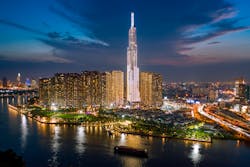While Osram's new owner ams is in the process of selling off parts of the general lighting business as it emphasizes chip-level operations, what's not yet known is exactly what will stay and what will go. LEDs Magazine has pointed out that the keepers are likely to include horticultural lighting. Now, if a passing reference in a recent Osram financial report is a clue, architectural lighting might also remain.
Osram's Traxon unit in recent years had taken something of a backseat as Osram tried to drive Internet of Things (IoT) connected lighting into the fast lane. But IoT has swerved, with the company's once-ballyhooed Lightelligence initiative all but leaving the road. All the talk of combining lighting-based sensors and communication chips with cloud data analysis to improve everything from building operations to retail sales has quieted to, at most, a whisper. For some time now it's been hard to find the word “Lightelligence” in any Osram press or marketing material. Instead, Lightelligence endeavors are lumped more or less into talk of “digital systems.”
In a first-half financial report for the six months ending Mar. 31 that Osram published on May 7, Osram noted that “revenue from control units and lighting management systems (Digital Systems) clearly declined.” Of course, the pandemic did not help. But IoT has been struggling for some time and Austria-based ams has labeled it as “non-core” to the combined company's mission.
In contrast to the IoT picture, Osram gave a much different and upbeat account for Traxon, which is not what pundits would generally consider to be “smart lighting” or “IoT.” Yes, Traxon has controls, in the form of Osram's own e:cue brand. But by and large, Traxon systems are not the Internet-savvy, data-collecting, brainy octopus that Lightelligence systems are — or perhaps were — meant to be.
When we last wrote about Traxon, Osram had installed a Traxon system for general illumination purposes at the Shenzhen World Exhibition Center. Traxon also serves as architectural and façade lighting, such as at Osram installations at the 1500-ft-tall Landmark 81 building in Ho Chi Minh City, and across 30 buildings and a bridge in Taiyuan, China.
Things seem to be going well with Traxon. In the same first-half report in which Osram provides a dim account of IoT results, the company wrote that “the lighting solutions business for buildings (Traxon) recovers with clear comparable revenue growth.”
Any other bright spots? “Also the business of specialty lighting for smart LED-based plant cultivation systems and industrial applications shows substantial growth,” Osram wrote.
As we have written before, horticultural lighting, including Osram's Fluence, would seem a good candidate to stay in the newly combined company, soon to be called ams Osram Group pending shareholder approval. Ams is headquartered in Premstaetten, Austria and is retaining slimmed-down Osram-related administration in Munich.
If business performance is an indicator, then perhaps Traxon will live on in the ams Osram stable as well.
The decision rests with the new ams-flavored management, which started the dismantling in February when Osram sold a factory that makes lighting components in Plovdiv, Bulgaria, to San Jose, CA-based contract manufacturer Sanmina.
Another unit that looks sure to go is Osram's entertainment group, which provides lighting for cinemas and theaters and has taken a hammering amid COVID-19 shutdowns.
It's not clear what direction ams Osram might take with UV-C lighting, although recently Osram acquired a 20% share in UV-C chip manufacturer Bolb Inc but also has released its own UV emitters.
On the chip side, as LEDs has reported, ams CFO and Osram CEO Ingo Bank has said that the company is evaluating “the manufacturing infrastructure and footprint,” which suggests that the company might be paring down or reassigning activities at its factories.
MARK HALPER is a contributing editor for LEDs Magazine, and an energy, technology, and business journalist ([email protected]).
For up-to-the-minute LED and SSL updates, why not follow us on Twitter? You’ll find curated content and commentary, as well as information on industry events, webcasts, and surveys on our LinkedIn Company Page and our Facebook page.

Mark Halper | Contributing Editor, LEDs Magazine, and Business/Energy/Technology Journalist
Mark Halper is a freelance business, technology, and science journalist who covers everything from media moguls to subatomic particles. Halper has written from locations around the world for TIME Magazine, Fortune, Forbes, the New York Times, the Financial Times, the Guardian, CBS, Wired, and many others. A US citizen living in Britain, he cut his journalism teeth cutting and pasting copy for an English-language daily newspaper in Mexico City. Halper has a BA in history from Cornell University.





